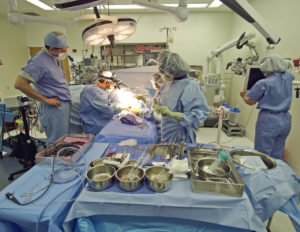Understanding Liability rom a Brain Aneurysm Misdiagnosis in Oregon
A brain aneurysm is a serious event that is considered to be a medical emergency. According to the Brain Aneurysm Foundation, misdiagnosis sadly occurs in up to 1/4 of cases. Additionally, misdiagnosis in 3 out of 4 cases is due to failure to conduct an imaging scan which is the gold standard for diagnosing brain aneurysms. If left untreated, a brain aneurysm can be deadly. While brain aneurysms can sometimes occur without warning and at no fault to medical staff, there are many cases in which a provider fails to identify a brain aneurysm which can result in permanent neurological damage, or even death. Our medical malpractice lawyers understand that a brain aneurysm misdiagnosis in Oregon is very serious and potentially deadly. We are prepared to review you case for FREE to determine if your brain aneurysm misdiagnosis was the result of medical malpractice.
This is because a brain aneurysm, while already a dangerous condition, can be a fatal condition if it is not properly treated and reacted to right away. This means diagnosing it immediately and insuring that a victim is immediately taken in to get the proper case. When a brain aneurysm is misdiagnosed, it can result in a death sentence. This means that a healthcare provider who is meant to protect the health and safety of a client could be committing a person to be wrongfully killed due to the negligence of someone who is supposed to heal a patient. This is unacceptable, especially when a person comes to the hospital with dangerous or deadly symptoms of a brain aneurysm and that person suffers by the inaction or malpractice of a healthcare provider. Victims and their families deserve the compensation they should get for medical bills, lost wages, and obviously pain and suffering. When a victim is wrongfully killed due to a brain aneurysm misdiagnosis, a family must be compensated as well to ensure their rights are also well protected.
What is a Brain Aneurysm?
A brain aneurysm is the result of continual weakening in the walls of a cerebral artery. Over time, the weakening ends up resulting in a rupture of the walls of a cerebral artery. According to Mayo Clinic, most brain aneurysms occur between the underside of the brain and the base of the skull. Once a brain aneurysm ruptures, it can cause life-threatening bleeding which can lead to death. Sometimes the rupture could result in death in a number of minutes, other times it could be hours. This depends on the type of leak and damage to the brain. A brain aneurysm misdiagnosis in Oregon can be very severe and devastating for these reasons.
Symptoms of a Brain Aneurysm
Anyone who believes that they may have a brain aneurysm should contact a healthcare provider immediately. This includes calling a hospital emergency department to let them know you are on the way if someone is able to drive you. If no one can drive you, call for an ambulance. Do not try to drive yourself.
The symptoms of a brain aneurysm include the following:
- Nausea
- Vomiting
- Neck pain or neck stiffness
- Visual changes
- Severe headache – sometimes referred to at the “worst headache ever”
- Eye pain
- Coordination changes
- Cognitive changes
- Memory changes
- Numbness
- Loss of consciousness
- Drowsiness
- Dilated pupils
- Drooping eyelid
- Seizure
- Light sensitivity
- Pain above or behind one eye
How is a Brain Aneurysm Diagnosed?
The diagnosis of a brain aneurysm is made based on assessment of the patient’s clinical symptoms, complaints and also with a series of tests to determine if an aneurysm is causing the symptoms. There are important to have done correctly because you want to ensure that a brain aneurysm misdiagnosis in Oregon does not occur. Diagnostic tests may include the following:
- CT scan – This is a type of imaging scan that is used to detect bleeding
- MRI – An MRI is another type of scan used to detect bleeding. Sometimes, an MRI angiography is used because this allows for more detailed visualization of the arteries.
- Cerebrospinal fluid test to detect if there are red blood cells in the cerebrospinal fluid. This could indicate a subarachnoid hemorrhage. This is performed if an aneurysm is suspected but a CT scan did not show evidence of a hemorrhage.
- Cerebral angiogram – This test is performed to detect bleeding but is usually used as a last resort as this test is more invasive. It involves a thin catheter being inserted into an artery which is then threaded into the brain. Dye is injected to see if a bleed can be detected.
How is a Brain Aneurysm Treated?
A brain aneurysm is usually treated with either surgery or another type of procedure. These include:
Surgical clipping – According to the Mayo Clinic, this procedure is performed to close off an aneurysm. A clip is placed on the neck of the aneurysm which stops blood flow to the aneurysm. This is a more invasive procedure as a portion of the skull is removed.
Endovascular Coiling – This procedure is less invasive than surgical clipping because it is not considered a surgical procedure. A small catheter is inserted into an artery and threaded through the body to the aneurysm. The wire is then put into the aneurysm which stops the blood flow and seals the aneurysm off.
Flow Diverters – This is a fairly new treatment which involves a tubular stent type of implant being placed which works to keep blood flow away from the aneurysm. This then allows for healing of the aneurysm.
How Can a Brain Aneurysm Be Misdiagnosed As the Result of Medical Malpractice?
- Patient complaints are dismissed
- Proper imaging and tests are not conducted
- Physician misdiagnosis the patient’s complaints for something else less serious (i.e. migraine or tension headache)
- Fails to assess patient and conduct proper neurological evaluation
- Improper procedure for aneurysm repair is performed, or is performed incorrectly
- Proper intervention is not given in an appropriate amount of time
How Can Our Oregon Brain Aneurysm Misdiagnosis Lawyers Help You?
If you or a loved on have been affected by a brain aneurysm misdiagnosis, you should reach out to our lawyers today. This is because there are some instances in which the misdiagnosis is caused by pure negligence which can really be a matter of life and death for the person. In the modern world of medicine, physicians have access to many diagnostic modalities that allow for prompt diagnosis and treatment of brain aneurysms. Failure to conduct a brain scan can literally cause a patient to die.
If our Oregon brain aneurysm medical malpractice lawyers identify your brain aneurysm misdiagnosis was caused by medical malpractice, you may be entitled to damages. In Oregon, damages are typically awarded in the form of compensation. Compensation for this type of medical malpractice claim can include the following:
- Pain and suffering including past and future pain and suffering
- Lost wages
- Lost future wages if unable to work in the same career and must take a lower paying job.
- Past, present and future medical bills
- Rehabilitation coverage including 24-hour nursing home care or treatment
- Therapy coverage for speech, occupational therapy and physical therapy
- Loss of consortium for relations with a spouse, and also loss of society with family, siblings, children, and others in a family, and
- Other damages related to the malpractice.
These are just a few of the many indications for damages for a person who experiences a brain aneurysm misdiagnosis due to medical malpractice.
Brain Aneurysm Misdiagnosis Cases in Oregon Should Come to Us
If you or a loved one have been seriously injured or killed as a result of medical malpractice contact the Oregon Medical Malpractice Lawyers at Kuhlman Law at our number below or fill out the intake form. We offer a free initial case evaluation and handle cases on a contingency fee which means that you pay no money unless we recover.
Our law firm handles cases throughout the state including Bend and Portland Oregon, Redmond, Central Oregon, Sisters, Madras, Multnomah County, Deschutes County, Salem, Eugene, Corvallis, Lane County, Medford, Gresham, La Grande, Albany, Medford, Beaverton, Umatilla, Pendleton, Cottage Grove, Florence, Oregon City, Springfield, Keizer, Grants Pass, McMinnville, Tualatin, West Linn, Forest Grove, Wilsonville, Newberg, Roseburg, Lake Oswego, Klamath Falls, Happy Valley, Tigard, Ashland, Milwakie, Coos Bay, The Dalles, St. Helens, Sherwood, Central Point, Canby, Troutdale, Hermiston, Silverton, Hood River, Newport, Prineville, Astoria, Tillamook, Lincoln City, Hillsboro, and Vancouver, Washington.
We also have an office in Minneapolis, Minnesota and take medical malpractice cases throughout the Twin Cities, including St. Paul, Hennepin County, Ramsey County, Dakota County, Washington County, Anoka County, Scott County, Blaine, Stillwater, and Saint Paul Minnesota.




